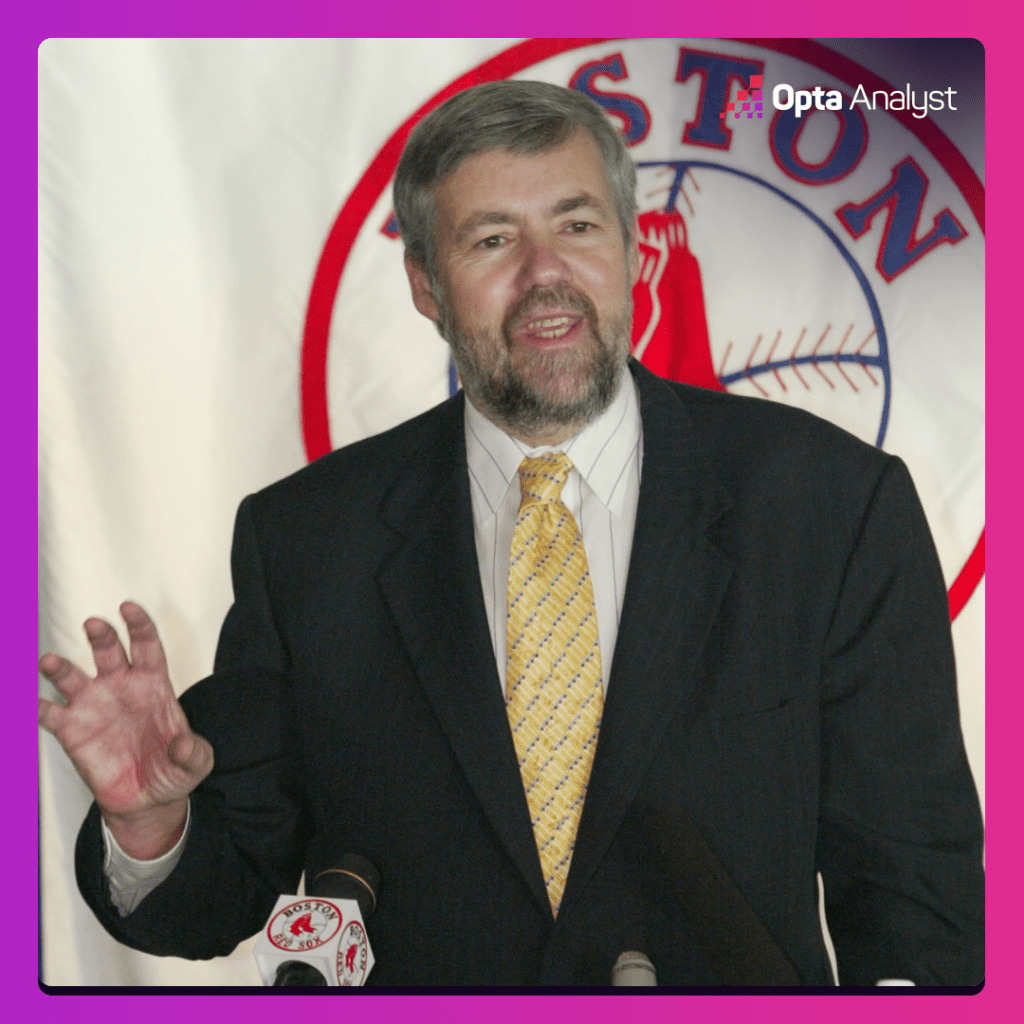SECAUCUS, N.J. – It’s opening day at MLB Network headquarters, and host Brian Kenny has just finished his first official “MLB Now” show of the 2024 season, filling it with analytically oriented baseball talk on set at the pristine Studio 21. Two of the show’s regular analysts, former major leaguers Carlos Pena and Al Leiter, join him to help launch the new season.
The opener had only been a wrap for a few minutes when Kenny sat down for a discussion with Opta Analyst. “I’m getting back in game shape,” he says with a laugh. “It was good! It was good to get Farhan (Zaidi, the Giants’ president of baseball operations) on. Joe Maddon (former World Series-winning manager) became a regular last year, and he’s excellent. Always so interesting.”
Kenny’s always interesting, too. He’s been with MLB Network since 2011, host of MLB Now, with the tagline “The Show for the Thinking Fan,” since 2013. He authored the data analytics book “Ahead of the Curve: Inside the Baseball Revolution” in 2017, and previously worked at ESPN for 14 years — serving as one of the nation’s foremost boxing experts in addition to being an announcer with other sports — and as the sports director for a TV station in Kingston, New York, for 11 years.
Kenny doesn’t “just” host MLB Now — which airs pretty much every weekday during the season at noon ET — he also appears on multiple shows for the network. For a kid who often visited Cooperstown, the opportunity for the 60-year-old native of New York to host the National Baseball Hall of Fame’s annual induction ceremony on MLB Network is special.
Nationally, though, he’s probably best known as the MLB Now host, and in that role, Kenny has been one of the faces of the advanced-stats revolution that’s swept the sport, though he’s always quick to give credit where credit is due.
That makes MLB Network’s Brian Kenny a perfect subject for a Q&A with Opta Analyst MLB writer Ryan Fagan.
Opta Analyst: Thanks for doing this. Let’s start here: What was your introduction to baseball analytics? I know it’s not a new thing for you.
Brian Kenny: It goes back to when I was a kid. I still have the books that I used to keep baseball stats in. I just really liked it, but that wasn’t abnormal for a guy my age. I would write in there, Jim Palmer was 22-9, with his ERA. I still have those books. I just always found it fascinating to mark down what baseball stats were.
So in the ’80s, when Bill James started writing about baseball, and then ‘Total Baseball’ came out like the late ’80s, early ’90s. I was always getting the latest Baseball Encyclopedia and always reading stuff, and there just seemed to be some new things in there, and it made sense. Like, why wouldn’t we want to know the slugging percentage? That’s a better statistic than batting average, and why wouldn’t you want the on-base percentage? That seems to be better than batting average, too. And then they had a thing called Total Player Rating. And then Bill James is writing about different ways of thinking about baseball. It just appealed to me intellectually, that there were certain things that weren’t quite covered.

Back when I was doing local sports, on Friday nights on my sports talk show in Kingston, New York, I would do Hall of Fame nights, debating who should be in the Baseball Hall of Fame. That was in the Ron Santo, Phil Rizzuto era. I’m always looking for new ways. I would use these charts and try to quantify it. I wasn’t just like, ‘Oh, Ron Santo should be there,’ I was like, ‘Let’s actually look at it.’ The tools weren’t as sophisticated as they are now, but I still tried to do a comparative analysis between guys like Brooks Robinson and George Brett. Then I would apply that to ballplayers who were actively playing.
Opta Analyst: Good start to what you’re doing now.
Brian Kenny: When I got to ESPN, I started doing ‘Baseball Tonight’ because I have all this baseball knowledge, and they realized that. That’s when you start having a long-form highlights, right? It’s not just highlights. It’s long-form baseball talk. Before that, I’m doing a Mets highlight, a Yankees highlight on my local broadcast. or high school baseball. But at ESPN, you have to come up with stuff. So I would just be studying, and the way I viewed the game was, ‘Hey, this guy is actually fifth in slugging percentage,’ and, ‘Hey, did you know Bobby Abreu has a .424 on-base percentage? It’s actually the third-highest in the league.’
People were looking at me like, ‘Why are you bringing up that?’ But that was something that was applicable to who’s good and who’s not. I just started branching from there and eventually got branded a heretic. I was like, ‘We’re all using numbers. I’m just using the latest numbers.’ It just evolved through the years. I love the history of baseball, studying baseball. I’m always wanting to break open a notepad and start comparing things and writing things down. And, why wouldn’t I want to use the latest tools and the latest things that make logical sense?
Baseball has always been a great love and so has logic. So those two together made this. I was not a math major. I was not mathematics or economics. It’s not my thing. I’ve just always wanted to think logically and efficiently, and that made sense.
Opta Analyst: Wanted to follow up on what you said, about basically being branded a heretic at some point. How do you handle it now when you mention analytics and somebody rolls his eyes? What do you think? How do you respond to that?
Brian Kenny: It’s so opposite now. It has completely been transformed. The whole industry is in. I recognized when I went to spring training for MLB Network one year, and when I started asking all my usual questions like, ‘Why don’t you do this and why don’t you do that? Can you use a four-man rotation? Can you use a six-man rotation?’ It was right around 2016 when every camp I went to, the answer started to be, ‘Everything’s on the table. Yeah, we might try that. We might do that.’ And I was like, ‘What’s happening?’ Instead of the old, ‘You gotta do what works and that doesn’t work. Grunt, grunt, spit, spit.’ Suddenly, everything was different. I wrote about in my book, Jeff Banister, who was the Texas Rangers’ manager, he’s one of the old guard, looks like Sergeant Rock (a fictional comic book character), but he had bought in. I suddenly saw everybody’s mind open up. I saw the whole industry change right in front of me, and change dramatically.
Opta Analyst: And not just the front office types, right?
Brian Kenny: Now, it’s players pushing. It’s a players’ analytics revolution. Now they want to get into the weeds on swing plane and how pitchers match up with the trajectory of the swing. They speak that language, so it’s totally transformed. And so my conversations have changed. It’s like, ‘OK, now that we all speak this language, let’s move on to what we don’t understand.’ And those are the kind of the things that Kevin Millar and Joe Maddon are talking about (both were on MLB Now on opening day). That’s why (I) seized on that word that Carlos (Pena) said – synergy. There are things that go together that have this exponential effect on the game. As Bill James still writes, there’s so much we don’t understand.

It’s a players’ analytics revolution. Now they want to get into the weeds on swing plane and how pitchers match up with the trajectory of the swing. They speak that language, so it’s totally transformed. And so my conversations have changed. It’s like, ‘OK, now that we all speak this language, let’s move on to what we don’t understand.’
Opta Analyst: You told me earlier today that you went to the SABR Analytics Conference this year. What were a couple takeaways from that experience?
Brian Kenny: My SABR Analytics talk this year, I mean, it was like looking at a college class. SABR Analytics is young, a lot of college kids and even high school kids giving Hall of Fame presentations. It’s amazing. There are analytics clubs in tons of high schools now and there are analytics majors in colleges. These kids are talking about an objective methodology from the get-go, so it’s drastically different. But I told them, ‘You’re answering these small, important questions, but remember, there are big questions that we don’t know the answers to, so don’t lose track of that.’ Like, the Padres are still wondering what happened last year. The Mets are still wondering what happened. The Cardinals are wondering what happened. And they’re still searching. So that’s kind of my thing now: ‘OK, now that we’re into the data, realize data is an abstraction of the real world. It reflects the real world, but it’s not the real world.’
I always hated the idea that it was time to rethink the role of analytics. No. I’m going beyond, right? Now that we understand there’s a direct connection between the data and the real world, realize it’s not encompassing the whole world. It’s giving you an abstraction.
Opta Analyst: I’m curious … when a player or topic pops into your mind that intrigues you, and you want to start maybe digging in, what are a couple of advanced stats that you’ll start with? I don’t mean necessarily what will wind up in the show, but what do you start with?
Brian Kenny: Oh, I start with the basics. I want to see the guy’s slash line. What’s his on-base, his slugging? If I had to hone it down to one thing, I usually use OPS+ and ERA+, or maybe wRC+, but it essentially arrives at the same spot. There is not a big difference. You can do a quick snapshot now and see how many guys on each team are above league average or below league average, so I start there. But it depends on what you’re looking for. You do have to do that dance between the different (web) sites to try to find everything you want to know. Like, what are his defensive metrics? Are there conflicting defensive metrics? Why would that be and what do I believe?
Opta Analyst: How about on the pitching side?
Brian Kenny: With pitching, despite there being such an advanced availability of expected stats, remember that the actual stats still matter, too. Your actual results matter. Look at, like, Spencer Strider (Atlanta Braves right-hander). A lot of people have Spencer Strider as the best pitcher in baseball and I can see why they’re thinking that, but I’m like, ‘No, no, no. You’re striking a ton of guys out and you’re not walking people and you’re getting really weak contact, but you’ve given up five runs. You’ve failed.’ That can be hard luck, sure. But if at the end of the year your ERA is 4.00, you were not great. You were angling toward great, but if you get into real world, you’ll see that maybe he gave up on some pitches. Maybe when a guy fouls off three or four in a row, he then will throw a fat pitch down the middle and give up that home run. Those things have happened recently.
There are guys where it’s like, ‘I know you’re missing bats and you’re not walking guys and you’re getting weak contact, but you’re giving up runs.’ That doesn’t mean nothing. It’s not all luck and happenstance. So that’s kind of where like the battle is now. I look at the results and I look at the expected results and then try to find what’s actually happening.
Opta Analyst: I hear you mention that and a guy like (Cincinnati Reds right-hander) Hunter Greene immediately comes to mind. He’s got all the tools and his stuff is just nasty and at some point you think he’s going to figure it out, but his ERA last year was like 4.80, and the year before that it was 4.40. So is it about mixing what those stats are and what you see and using both to figure it out?
Brian Kenny: A lot of times it does show you who’s about to emerge. That’s where it’s really useful. But with a guy like Hunter Greene, or even like (Mets closer) Edwin Diaz (in) his bad year, he was still striking guys out and he was not walking guys, but he was failing. So he was failing. It wasn’t luck. It wasn’t just the variants of the batted ball. We need to continue to evolve analytically sabermetrically. We don’t have to fight those old fights. We know a lot of it is happenstance. We know a lot of it is variance and we know a lot of it is luck and everything else, but it’s not all that. There is something to what Kevin Millar mentioned, the grits and guts and being in there every day and fighting every pitch. There’s something to that.
Opta Analyst: Absolutely. Brian, this has been great. Really appreciate it.
Check out our MLB, NBA and NFL coverage as well as our college basketball picks. Follow us on X and Instagram for more!
